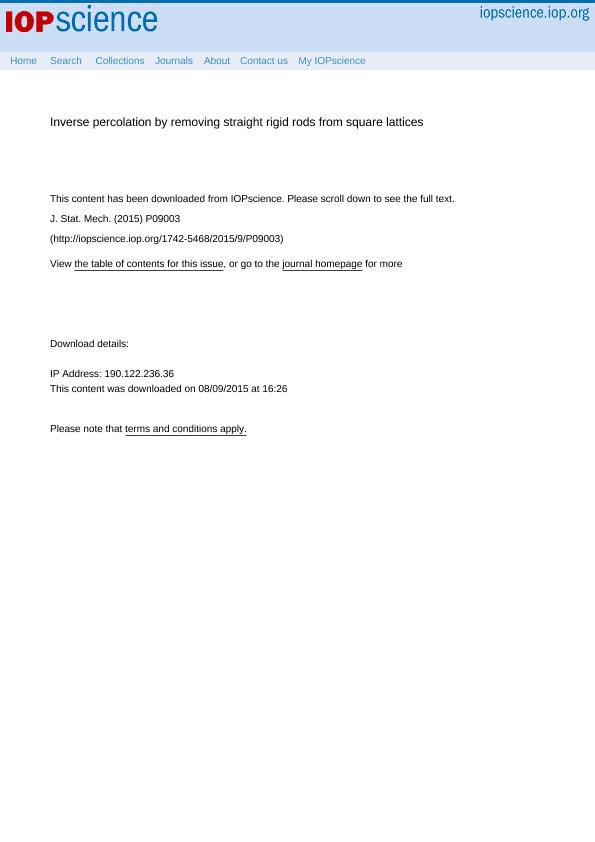Artículo
Inverse percolation by removing straight rigid rods from square lattices
Fecha de publicación:
09/2015
Editorial:
Iop Publishing
Revista:
Journal Of Statistical Mechanics: Theory And Experiment
ISSN:
1742-5468
Idioma:
Inglés
Tipo de recurso:
Artículo publicado
Clasificación temática:
Resumen
Numerical simulations and finite-size scaling analysis have beencarried out to study the problem of inverse percolation by removing straightrigid rods from square lattices. The process starts with an initial configuration, where all lattice sites are occupied and, obviously, the opposite sides of the lattice are connected by nearest-neighbor occupied sites. Then, the system is diluted by randomly removing straight rigid rods of length k (k-mers) from the surface. The central idea of this paper is based on finding the maximumconcentration of occupied sites (minimum concentration of holes) for whichconnectivity disappears. This particular value of concentration is called theinverse percolation threshold, and determines a well-defined geometrical phasetransition in the system. The results, obtained for k ranging from 2 to 256,showed a nonmonotonic size k dependence for the critical concentration,which rapidly decreases for small particle sizes (1 ⩽k ⩽3 ). Then, it growsfor k = 4, 5 and 6, goes through a maximum at k = 7, and finally decreasesagain and asymptotically converges towards a definite value for large valuesof k. Percolating and non-percolating phases extend to infinity in the space ofthe parameter k and, consequently, the model presents percolation transitionin all ranges of said value. This finding contrasts with the results obtainedin literature for a complementary problem, where straight rigid k-mers arerandomly and irreversibly deposited on a square lattice, and the percolationtransition only exists for values of k ranging between 1 and approximately1.2 × 10^4. The breaking of particle-hole symmetry, a distinctive characteristicof the k-mers statistics, is the source of this asymmetric behavior. Finally, the accurate determination of critical exponents reveals that the model belongs to the same universality class as random percolation regardless of the value of kconsidered.
Archivos asociados
Licencia
Identificadores
Colecciones
Articulos(INFAP)
Articulos de INST. DE FISICA APLICADA "DR. JORGE ANDRES ZGRABLICH"
Articulos de INST. DE FISICA APLICADA "DR. JORGE ANDRES ZGRABLICH"
Citación
Ramírez, Lucía Soledad; Centres, Paulo Marcelo; Ramirez Pastor, Antonio Jose; Inverse percolation by removing straight rigid rods from square lattices; Iop Publishing; Journal Of Statistical Mechanics: Theory And Experiment; 2015; 9-2015; 1-18
Compartir
Altmétricas




